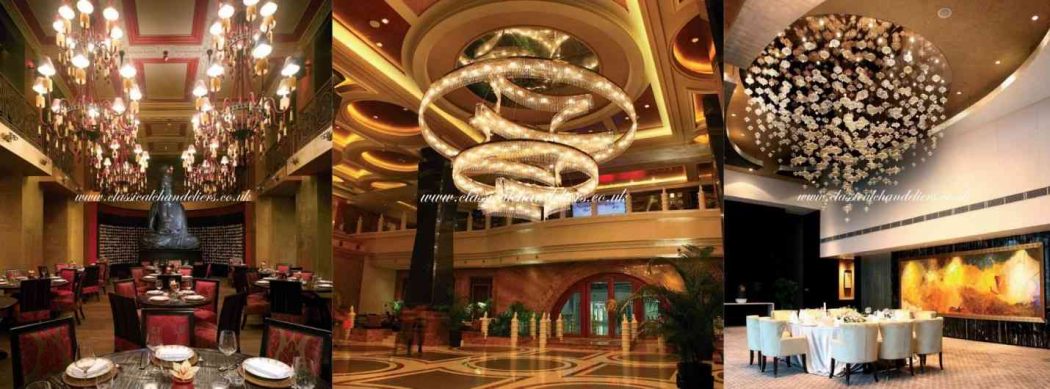Chandeliers are known to provide some elegance and charm to your space and when they come with crystals, they become more luxurious and noteworthy. But before buying crystal chandeliers, you must gain some information about the types of crystals that are being used in these striking light fixtures. In the modern market of the chandeliers, being knowledgeable about crystal chandeliers will help you in taking the right purchasing decision as per your style, budget and space.
If you want your guests to be impressed by your choice, then read on to find some more intriguing details about the bling of crystal chandeliers!
THE UNBREAKABLE BOND BETWEEN CHANDELIER AND CRYSTALS!
Crystals are made up of glasses, but it is not the same glass which is used in your windows, eyeglasses, drinking cups or anything else. The crystals of a chandelier contain lead oxide, which have more refraction and weight as compared to the normal glass. This implies that crystals will glint more, appear brilliant and will be prismatic.
Lead oxide is an essential thing for the crystals and it is completely safe for the health of the consumers. Actually, the rule is, the more is the amount of lead oxide, the more will be the reflection and shine. So, it is good to have higher content of lead oxide. There are three forms of lead oxide content:
- Full lead crystal is the one in which the amount of lead oxide is above 30%.
- Half lead designation means that the content of the lead oxide will be between 24% and 30%.
- The last is crystalline in which glass has about 6% to 10% lead oxide, but as per standards in some countries, any clear glass with any amount of lead oxide can be called crystal.
There are usually three methods of designing crystals for crystal chandeliers- (a) hand-blown, (b) hand-cut and (c)machine-cut.
#1 Hand-blown Method
Murano and Venetian crystals are hand-blown by the artisans. This process proffers smoothness and round edges to the crystals. The hand-blown crystals are work of a art and produce only high quality pieces. Not everyone can design mouth-blown crystals as this requires high expertise and precision.
#2 Hand-cut Method
The hand-cut crystals are crafted by making use of the traditional methods, which uses irons and sandstone wheels for the purpose of cutting. Then, polishing is done on a wood wheel having marble dust in it. But, they can even be designed by utilizing modern techniques. Some of the most common varieties of hand-cut crystals are Heritage, Czech, Regal, Turkish and Crystalline.
#3 Machine-cut Method
The machine-cut crystals are produced by using sharp facets, visual purity and precise polishing.
Let’s talk about types of chandelier crystals now!!
Now, you know that chandelier crystals can be crafted with three basic methods, but knowing the type is also essential. Here are some of the crystals that you might see while shopping for the best crystal chandeliers for your abode.
#1 Rock Crystals:
These can be seen in the antique crystal chandeliers, which date back in the 16th century and displaced the ordinary wax candles as the way to amplify and reflect light in the surroundings of a home. Nowadays, you can see the genuine rock crystals chandeliers only in the museums and the palaces. If you ask any chandelier expert, then he would say that rock crystals are as old as earth itself and every piece is unique. They were actually created by the geological events, which took place about a millions of years ago. They appear classy and more of natural, but in order to get their real aura they are required to be cut by gem cutters.
#2 Colored Crystals:
Then comes the colored crystals, which are used in various types of chandeliers in order to fabricate some different effects. You can find any color you can think of in colored crystals. Actually, the color is coated onto the crystals.
#3 Venetian Crystals:
- Hailing from Italy and Venice, the Venetian crystals are not cut but molded. They generally have round edges due to the fire polishing. Also, they contains lime and soda instead of lead oxide, thus they look very soft. Although, they are not as stunning as cut crystals, but provides a good budget option for the customers. Similar mouth-blown technique is used for creating the Murano crystals which can be easily shaped into flowers, circles or any other shape. Murano crystals can even be coloured.
- In Gemcut or Egyptian crystals you can find high lead oxide content. They are very much clear, flawless and sharp, but yes not as pure as Swarovski crystals in an optical manner.
- Swarovski is the most brilliant type of crystals that you can ever find. Manufactured in Austrian Alps, they are pure, peculiar, flawless and clearer. Created using machines, they contain more than 30% of lead content. Some of them even have an optical coating for easy cleaning.
So, now you know all about the crystal chandeliers. Hopefully, you can make a more efficient choice now. After all a chandelier is all about the charm of crystals!








